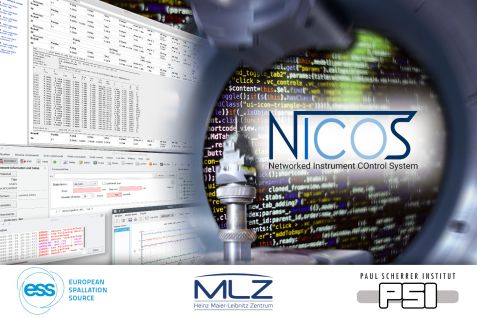MLZ is a cooperation between:
 > Technische Universität München
> Technische Universität München > Helmholtz-Zentrum Hereon
> Helmholtz-Zentrum Hereon
 > Forschungszentrum Jülich
> Forschungszentrum Jülich
MLZ is a member of:
 > LENS
> LENS > ERF-AISBL
> ERF-AISBL
MLZ on social media:

MLZ (eng)
Lichtenbergstr.1
85748 Garching
20.12.2021
Software from Garching goes global

A total of nine research institutes in seven different countries are already using the NICOS software. Three more international institutions are planning to introduce the program soon. © Reiner Müller, FRM II / TUM
NICOS is the link between the scientific instruments and visiting researchers during neutron experiments. The software, originally developed at the Heinz Maier-Leibnitz Center (MLZ), is now in demand worldwide and is increasingly expanding its user community.
When researchers study their samples at the Heinz Maier-Leibnitz Zentrum (MLZ) in Garching, they conduct their neutron experiments together with the instrument scientists on site. The latter support their guests during the entire measurement phase, from sample preparation through to data evaluation. In addition to the instrument scientists, however, another indispensable helper is always on hand: NICOS. The Networked Instrument COntrol System connects visiting researchers and instrument scientists with each other and facilitates their cooperation in many ways.
Digital experiment diary
Since NICOS is network-based, scientific instruments can also be remotely controlled allowing scientists from abroad access to the MLZ – a particularly helpful feature during the Corona pandemic. In addition to the experiment results, NICOS also stores information about the status of the instrument during the measurements. Thus, the software maintains a comprehensive digital experiment diary that is permanently available to the scientific community.
Flexibility and recognition value

The flexible open source software spreads mainly by word-of-mouth to research institutions worldwide. © Reiner Müller / FRM II
The software can be used for almost all instruments offering experiments with neutrons. This flexibility and also the recognition value of NICOS are among the main reasons for the software’s popularity, according to Jens Krüger, head of instrument control of FRM II at MLZ. “For our users, quick and easy familiarization with the measurement software is particularly important because it saves them a lot of valuable time,” the physicist explains. Especially when researchers measure on several instruments, NICOS is a true friend.
One software for all
Not only has NICOS become the number one instrument software at MLZ, it is also attracting increasing attention worldwide. For example, the system will also be used at the European Spallation Source (ESS) in Lund, Sweden. Matt Clarke, who is supporting the introduction of NICOS there as a software scientist, explains why: “We chose NICOS because neutron scientists often spend time at different facilities, and they can thus reuse their knowledge from the MLZ at the ESS and vice versa.” NICOS is also very advantageous from a developer’s point of view, Clarke points out. The Python programming language on which NICOS is based is widely used and allows rapid progress in software development.
Worldwide boom through word-of-mouth
For the instrument control staff at MLZ, the lively worldwide interest leads to full calendars: With colleagues already in Switzerland, Austria, Sweden, Russia, Argentina, USA and Indonesia, the list of research institutes and universities interested in NICOS keeps getting longer and longer. Jens Krüger believes he knows the reason for this rapid development: “Visiting researchers who use NICOS at MLZ often pass on the software to other institutions. This word-of-mouth is worth a lot!”
Strong Open Source Project
Currently, the instrument control teams at MLZ are leading the software development of NICOS; however, due to the increasing user numbers, new ideas are constantly being added. Jens Krüger is pleased about the growing developer network as it is precisely this community that forms the basis for the strong open source project: every user is invited to participate in the software development and thus contribute collectively to the success of the program.
More information:
Youtube-film of the presentation NICOS: Flexibles Experimentieren an Großforschungsgeräten dank Python
MLZ is a cooperation between:
 > Technische Universität München
> Technische Universität München > Helmholtz-Zentrum Hereon
> Helmholtz-Zentrum Hereon
 > Forschungszentrum Jülich
> Forschungszentrum Jülich
MLZ is a member of:
 > LENS
> LENS > ERF-AISBL
> ERF-AISBL
MLZ on social media:


